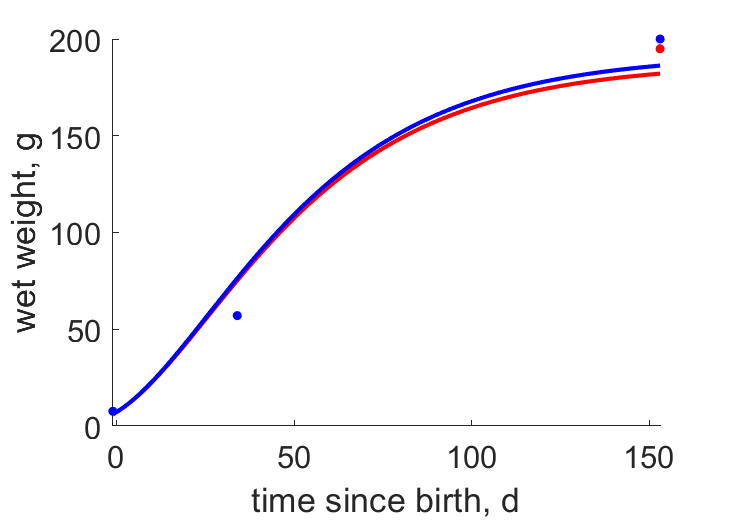Predictions & Data for this entry
| Model: std | climate: B | migrate: | phylum: |
| COMPLETE = 2.5 | ecozone: THn | food: bxCi, biHs | class: |
| MRE = 0.074 | habitat: 0iTi | gender: Dg | order: |
| SMSE = 0.012 | embryo: Tnsf | reprod: O | family: |
Zero-variate data
| Data | Observed | Predicted | (RE) | Unit | Description | Reference |
|---|---|---|---|---|---|---|
| ab | 22 | 23.52 | (0.06906) | d | age at birth | avibase |
| tx | 3 | 2.995 | (0.001684) | d | time since birth at fledging | avibase |
| tp | 200 | 143.4 | (0.2828) | d | time since birth at puberty | explorer |
| tR | 365 | 365 | ( 0) | d | time since birth at first reproduction | avibase |
| am | 5475 | 5472 | (0.000477) | d | life span | guess |
| Ww0 | 10.3 | 9.321 | (0.09505) | g | intitial wet weight | avibase |
| Wwb | 7.5 | 7.01 | (0.06531) | g | wet weight at birth | avibase |
| Wwi | 177 | 187.8 | (0.06112) | g | ultimate wet weight | avibase |
| Wwim | 191 | 192.3 | (0.006548) | g | ultimate wet weight for males | avibase |
| Ri | 0.03562 | 0.03268 | (0.08231) | #/d | maximum reprod rate | avibase |
Uni- and bivariate data
| Data | Figure | Independent variable | Dependent variable | (RE) | Reference |
|---|---|---|---|---|---|
| tW |   | time since birth | wet weight | (0.1281) | DabbPlea2020 |
Pseudo-data at Tref = 20°C
| Data | Generalised animal | Callipepla squamata | Unit | Description |
|---|---|---|---|---|
| v | 0.02 | 0.01881 | cm/d | energy conductance |
| p_M | 18 | 1519 | J/d.cm^3 | vol-spec som maint |
| k_J | 0.002 | 0.06229 | 1/d | maturity maint rate coefficient |
| k | 0.3 | 0.3005 | - | maintenance ratio |
| kap | 0.8 | 0.5051 | - | allocation fraction to soma |
| kap_G | 0.8 | 0.7996 | - | growth efficiency |
| kap_R | 0.95 | 0.95 | - | reproduction efficiency |
Discussion
- Males are assumed to differ from females by {p_Am} only
- mod_1: Pseudo-data point k is used, rather than k_J; Parameter t_R is added, replacing clutch interval t_N. Postnatal T is based on PrinPres1991, see get_T_Aves. See further the revision page, theme puberty
Bibliography